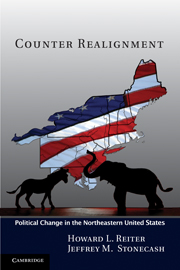Book contents
- Frontmatter
- Contents
- List of Figures
- List of Tables
- Preface
- Acknowledgments
- Postscript: Democratic Fortunes in the Northeast in 2010
- 1 Party Strategies and Transition in the Northeast
- 2 Party Pursuits and the Sources of Change
- 3 The First Republican Losses
- 4 Searching for a Majority, the Rise of Conservatives, and Second Losses
- 5 Interpreting the Goldwater Election and Pursuing the South
- 6 Social Change, Party Response, and Further Republican Losses
- 7 National Parties and the Position of the Northeast
- 8 The Process of Change and the Future
- Index
- References
2 - Party Pursuits and the Sources of Change
Published online by Cambridge University Press: 05 June 2012
- Frontmatter
- Contents
- List of Figures
- List of Tables
- Preface
- Acknowledgments
- Postscript: Democratic Fortunes in the Northeast in 2010
- 1 Party Strategies and Transition in the Northeast
- 2 Party Pursuits and the Sources of Change
- 3 The First Republican Losses
- 4 Searching for a Majority, the Rise of Conservatives, and Second Losses
- 5 Interpreting the Goldwater Election and Pursuing the South
- 6 Social Change, Party Response, and Further Republican Losses
- 7 National Parties and the Position of the Northeast
- 8 The Process of Change and the Future
- Index
- References
Summary
Over the span of a century, the Northeast has gone from being solidly Republican to solidly Democratic. What explains such a dramatic transition? How does a party lose a region that from 1870 to 1930 was solidly Republican and from 1932 to 1964 was at least divided between the two parties? The answer involves the nature, purposes, and pursuits of parties.
American political parties are loose coalitions of elected officials, activists, and groups with diverse interests. Those who work within a party may be motivated by the desire to win power, to enact specific policies, or both. They presumably have some commonality of concerns, which may involve ideology, regional history, economics, cultural concerns, ethnicity, group identity, or some combination of these and other factors. Although those working within a party may share some common purposes and the desire to win the next election, the party rarely acts as a unified, unitary actor. The “party” is often composed of actors with differing views of what policy positions the party should be pursuing and what strategies will bring victory. Elites seek to shape these internal debates but just as often end up reacting to and trying to cope with competing policy demands. The initiatives for policies come as much from groups wanting some policy as from elites seeking to win the votes of groups.
- Type
- Chapter
- Information
- Counter RealignmentPolitical Change in the Northeastern United States, pp. 15 - 31Publisher: Cambridge University PressPrint publication year: 2011



